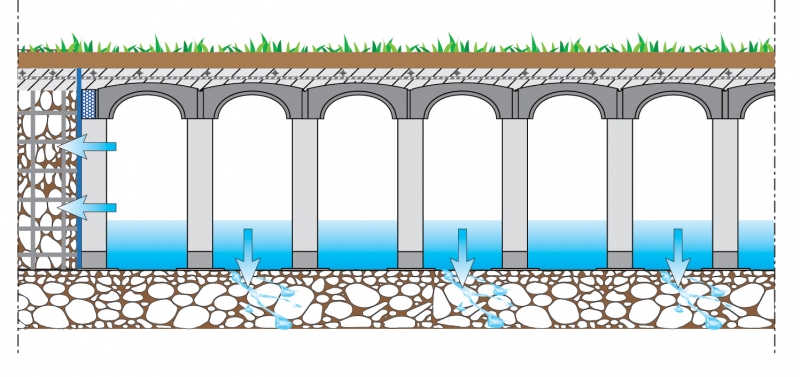The implemented tank can be loaded directly on the concrete layer or be positioned underground to create an asphalted parking lot or a green area on the surface.

In comparison to collection tanks, dispersion tanks are not perfectly waterproof but permit the gradual release of the rainwater to the water bed through slits in the walls or draining bottom.
Dispersion tanks are a means for rebalancing the ground water that have been decreased due to cementification, which has seriously reduced the natural draining capacity of the ground. As seen previously, on a river basin level, the dispersion tanks could be a tool for planning, thereby decreasing, the hydrogeological risk.
On a public level, on a river basin level, there are many benefits:
• relieving the sewage system in the case of heavy rain and resulting reduction in the capacity delivered to the purifiers and the final destination (rivers, lakes, sea, etc.);
• the local hydrological balance is preserved.
The implemented tank can be loaded directly on the concrete layer or be positioned underground to create an asphalted parking lot or a green area on the surface.
Considering a more local scale, other areas of use can be defined such as the sewer system (drain sewage and mixed). It is also influenced by the rain and normally must be made larger as the urban area expands. The use of dispersion tanks, also concentrated in various points of the territory where the rain water collected from multiple areas is directed, would make it possible to reduce the costs related to creating many small sized basins and lower the collective costs to permit an increase in the sewer capacity. A careful cost-benefit analysis could lead local authorities to introduce urban planning obligations to locally disperse rainwater, maintaining the water balance, reducing the collective system management costs, supplying local ground water, promoting more sustainable growth.
The benefits on a public level, on a community scale, are:
• the public collection networks will not need to be expanded because of the excess rainwater that is not absorbed by the ground on an urban level, due to progressive cementification, is kept or dispersed locally;
• decrease in the risk of saturation of the sewer system
• supplying local ground water
SUGGESTED PRODUCTS:
